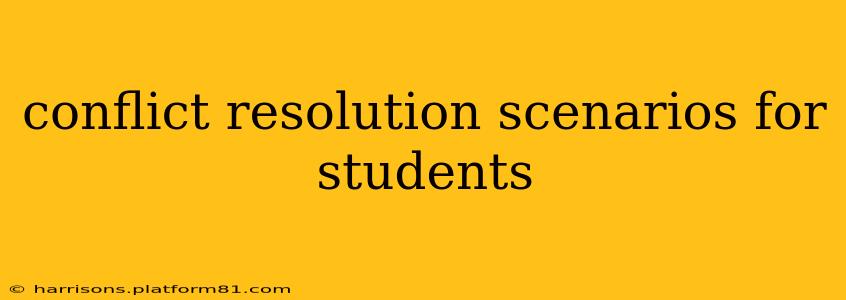Conflict is an inevitable part of life, and learning to resolve disagreements constructively is a crucial life skill. This is especially true for students, who frequently interact with peers and adults in diverse settings. This article explores various conflict resolution scenarios for students, offering practical strategies and insights for navigating disputes effectively. We'll cover scenarios ranging from minor disagreements to more complex conflicts, providing valuable tools for both educators and students.
Common Conflict Scenarios in Schools
Students face conflicts in numerous school settings: classrooms, hallways, playgrounds, and even online. Understanding the common types of conflict can help facilitate proactive and effective resolution.
Scenario 1: Playground Disputes – Sharing Toys and Equipment
This is a classic scenario: two or more students want to use the same toy or piece of equipment at the same time. Arguments often stem from feelings of unfairness and a lack of clear rules.
Resolution Strategies: Introduce the concept of "taking turns," negotiating playtime limits, and finding alternative solutions (e.g., sharing, finding another toy). Educators can facilitate this by establishing clear playground rules and providing opportunities for students to practice conflict resolution skills in a safe environment.
Scenario 2: Classroom Conflicts – Academic Disputes and Cheating Allegations
Disagreements over assignments, grades, or accusations of cheating can escalate quickly. These conflicts often involve strong emotions and require sensitive handling.
Resolution Strategies: Encourage open communication between students and teachers. Establish clear academic expectations and grading criteria. For cheating allegations, ensure a fair and impartial investigation, providing students with the opportunity to explain their actions.
Scenario 3: Bullying and Cyberbullying
This is a serious issue requiring immediate attention. Bullying can take many forms, from physical aggression to social exclusion and online harassment.
Resolution Strategies: Establish a zero-tolerance policy for bullying and cyberbullying. Provide students with a safe and confidential way to report incidents. Collaborate with parents, school counselors, and other professionals to address bullying behaviors and support victims.
What are Some Common Causes of Conflict Among Students?
Conflicts arise from a variety of underlying causes, understanding these is crucial for effective resolution:
Misunderstandings and Miscommunication:
Sometimes, conflicts stem from simple misunderstandings. A lack of clarity in communication can lead to misinterpretations and disagreements.
Resolution Strategies: Encourage active listening and clear communication. Teach students to paraphrase what they hear to ensure understanding. Model effective communication skills in the classroom.
Competition and Resource Scarcity:
Limited resources (e.g., attention from teachers, desirable toys, coveted spots in group projects) often trigger conflict.
Resolution Strategies: Implement fair allocation systems for resources. Teach students about cooperation and collaboration rather than solely focusing on individual achievement. Promote empathy and understanding of others' perspectives.
Differing Values and Beliefs:
Conflicts can arise from differences in beliefs, values, or cultural backgrounds. These differences can lead to misunderstandings and disagreements.
Resolution Strategies: Promote tolerance and respect for diverse perspectives. Create a classroom environment where students feel comfortable sharing their beliefs and values without fear of judgment. Teach about cultural sensitivity and empathy.
How Can Students Effectively Resolve Conflicts?
Empowering students with conflict resolution skills is vital:
Active Listening:
Truly hearing and understanding the other person's perspective is fundamental. This involves paying attention, asking clarifying questions, and summarizing the other person's point of view.
Empathy and Perspective-Taking:
Trying to understand the other person's feelings and motivations is essential for de-escalating conflict.
Negotiation and Compromise:
Finding mutually acceptable solutions often involves negotiation and compromise. This requires a willingness to give and take.
Collaboration and Teamwork:
Working together to find a solution that benefits everyone involved is often the most effective approach.
How Can Teachers Help Students Resolve Conflicts?
Teachers play a critical role in fostering a positive classroom climate and teaching conflict resolution skills:
Modeling Positive Behavior:
Teachers should model respectful communication and conflict resolution strategies in their own interactions.
Creating a Safe and Supportive Classroom:
Establishing clear expectations for behavior and creating a supportive classroom environment can reduce conflict.
Providing Opportunities for Conflict Resolution Practice:
Incorporating role-playing and simulations can provide valuable practice for students.
Teaching Conflict Resolution Strategies:
Explicitly teaching students conflict resolution strategies can equip them with essential life skills.
By proactively addressing conflicts and teaching students effective resolution strategies, we can foster a more peaceful and productive learning environment, preparing them for successful navigation of future disagreements in all aspects of their lives.
